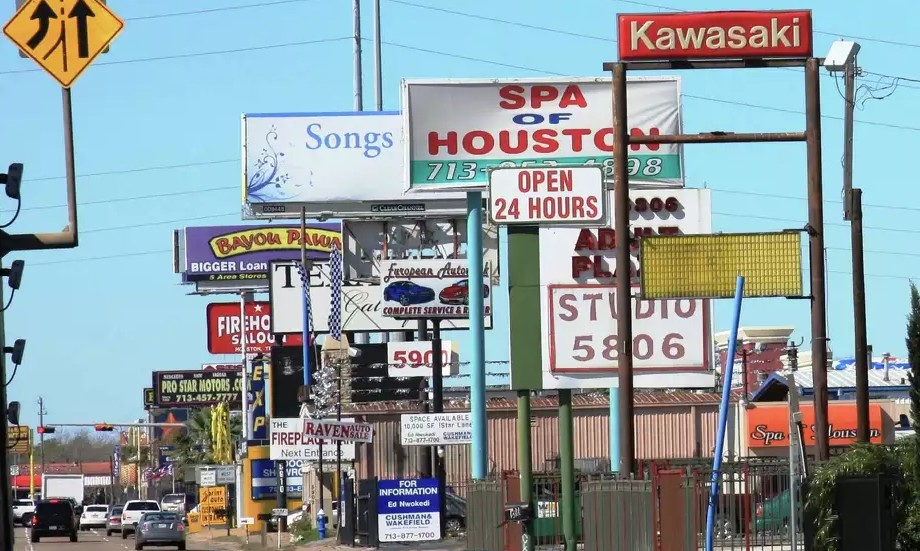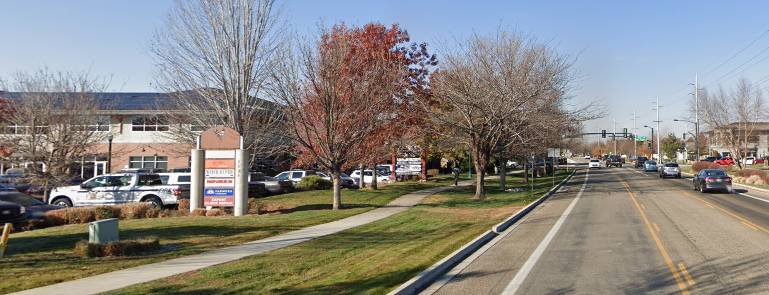Billboards
We all know and hate billboards. The big signs that blight our roadways; as if concrete roads, filled with traffic and lined by strip malls weren't ugly enough.

A billboard as defined by a billboard company is-
A Bulletin is the largest standard-sized billboard that delivers maximum exposure to vehicular traffic on expressways, highways and primary arteries. How big is a billboard? Typically 14 feet high and 48 feet wide, a bulletin provides 672 square feet of space for your ad. Bulletins offer unparalleled visibility.
- Large-format advertising structures located on major highways, expressways and primary arteries
- Visible to drivers, commuters and long distance travelers
- Command your audience’s attention with creative three-dimensional designs, moving parts and extensions
Text via Lamar, emphasis mine
Busniess and Law
Many entities want to eliminate billboards. Houston, Salt Lake City, Bloomington and others are trying to reduce or eliminate billboards, with varying success. Bloominton is expecting to pay-out, I believe under the "takings" clause.
We need to take a fresh look at the purpose and design of billboards before deciding if they should be reduced or eliminated.
According to the companies that produce and install these enourmouse advertisements, their purpose is to be placed along high traffic areas and "command attention". Driving a 2-ton automobile at high speeds is dangerous to begin with. Governments at all levels in all areas try to reduce distracted driving. According to the CDC, "Anything that takes your attention away from driving can be a distraction."
Let me repeat the quotes from the CDC and Lamar back to back.
- "Anything that takes your attention away from driving can be a distraction."
- "Command your audience’s attention"
Billboards make advertising companies money. Billboards make the companies advertising money. This is NOT a problem. But their stated method of doing so is by distracting drivers. This IS a problem.
Driver's can get in legal trouble by distracting themselves. Texting, reading, watching TV, or whatever other crazy things you can think of. Companies are allowed to to spend billions for the purpose of distracting drivers.
How big is the industry? Lamar is the largest but only holds 28% of the market. They claim over 360,000 display and over 4,600 digital billboards. Total revenue for the industry is about 4.2 billion annualy.
How big is the problem? The most comprehensive review of the literature to date by the Centre for Accident Research and Road Safety-Queensland found that crash risk increases by approximately 25-29% in the presence of digital roadside advertising signs (digital billboard) compared to control areas. source
Four states have already banned billboards. Should the other 46 follow suit? Yes. Their obligation is to the safety of drivers. They have zero obligation to enable advertisers to distract drivers.
This isn't an attack on advertising business or a ban on free speech. This has nothing to do with the content on the billboards. Much like you can't yell "fire!" in public building, you shouldn't be able to distract drivers on a road. I don't have a problem with billboards themselves, put them in a location where nobody is driving.
There are plenty of laws and regulations in existence that are similar. We have the right to free speech but most juridictions have some type of noise ordinace. The FAA says you can't shoot a laser at an aircraft, nobody sued the FAA for taking their right to operate their laser.
By design, billboards distract drivers and take their attention off the road. By duty, governement agencies are there to create laws and regulations that protect people. These two are incompatible.
Beauty


Enough Said.
Purpose
GPS and smartphones are almost everywhere, at least in the US. The purpose of billoards isn't to be helpful to drivers. Labeling a business in a helpful way is fine. Will it help a driver be in the correct lane or turn into the correct drive? That is a benefit to all drivers.

Small signs that let driver know where the turn is can be helpful. Helpful, not a destraction.